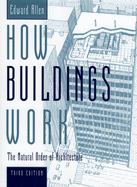
How Buildings Work
by Edward Allen (Illustrator), David Swoboda (Illustrator)
ISBN-10: 019516198X
ISBN-13: 9780195161984
$45.00
Book Specs
Binding
Trade Cloth
Publisher
Oxford University Press
Published on
Sep 1, 2005
Edition
3rd Edition
Dimensions
11.24x8.70x0.98 Inches
Weight
2.25 Pounds
About the Book
Illustrated with hundreds of illuminating line drawings, this classic guide reveals virtually every secret of a building's function: how it stands up, keeps its occupants safe and comfortable, gets built, grows old, and dies--and why some buildings do this so much better than others.Drawing on things he's learned from the many buildings he himself designed (and in some cases built with his own hands), Edward Allen explains complex phenomena such as the role of the sun in heating buildings and the range of structural devices that are used for support, from trusses andbearing walls to post-tensioned concrete beams and corbeled vaults. He stresses the importance of intelligent design in dealing with such problems as overheating and overcooling, excessive energy use, leaky roofs and windows, fire safety, and noisy interiors. He serves up some surprises: thermalinsulation is generally a better investment than solar collectors; board fences are not effective noise barriers; there's one type of window that can be left open during a rainstorm. The new edition emphasizes "green" architecture and eco-conscious design and construction. It features a prologue onsustainable construction, and includes new information on topics such as the collapse of the World Trade Center, sick building syndrome, and EIFS failures and how they could have been prevented. Allen also highlights the array of amazing new building materials now available, such as self-cleaningglass, photovoltaics, transparent ceramics, cloud gel, and super-high-strength concrete and structural fibers.Edward Allen makes it easy for everyone--from armchair architects and sidewalk superintendents to students of architecture and construction--to understand the mysteries and complexities of even the largest building, from how it recycles waste and controls the movement of air, to how it is keptalive and growing.
